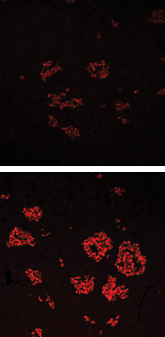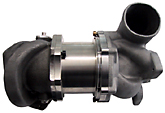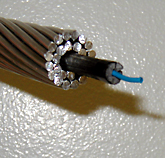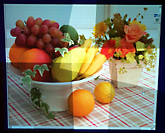
 |
|
Prototype![]()
Prototype July/August 2002
Straight from the lab: technology's first draft
Greasy-Spoon Cleaner
The frenzied cooking and cleaning in a typical restaurant generates large
volumes of water permeated with oil and grease. While big restaurants can afford
their own wastewater treatment facilities, smaller establishments usually
discharge wastewater straight into the closest sewer systems. Chemical engineers
at the Hong Kong University of Science and Technology have developed a compact
and inexpensive technology for cleaning restaurant wastewater.
 |
| The pancreas of a diabetic animal has very few insulin-producing cells (top). After treatment with INGAP, it has more insulin-producing cells (bottom). (Images courtesy of Strelitz Diabetes Institutes at Eastern Virginia Medical School) |
Destroying Diabetes?
Diabetics could one day live lives free of needles and implants thanks to a
new treatment that can prompt the body to generate new insulin-producing cells.
Researchers Aaron Vinik of Eastern Virginia Medical School and Lawrence
Rosenberg of McGill University discovered that a fragment of a protein known as
INGAP stimulates cells in the pancreas of adult animals to develop into “islet”
cells that make insulin in response to blood sugar. In animal experiments, a few
weeks of daily injections of the protein segment yielded normal blood sugar and
insulin levels. GMP of Fort Lauderdale, FL, which licensed the technology, has
started human trials in patients with both Type 1 (juvenile) and Type 2 (adult
onset) diabetes. The treatment could become available in about five years. One
question that remains is whether Type 1 diabetics, whose bodies have destroyed
their own islet cells, would be able to sustain the new cells without immune
suppression.
Mega Memory
Computer hard drives store massive amounts of information, but they write and
retrieve it slowly. University of Houston physicist Alex Ignatiev
has developed a new memory chip that could perform such tasks in an instant. In
the short term, the chips might replace the slow and expensive flash memory
cards used in digital cameras and deliver “nonvolatile” random access memory
that will retain data even if a PC crashes.
 |
| Exhaust compresses clean air inside cylinder. (Photo courtesy of the Swiss Federal Institute of Technology) |
Drive the Wave
Turbochargers give hot rods screeching-fast acceleration, using the force of
exhaust gases to spin a turbine and compress air flowing into combustion
chambers. But there’s a slight lag after you hit the gas, and it gets worse as
the engine gets smaller, making the technology impractical for economy cars.
Work at the Swiss Federal Institute of Technology in Zürich has yielded a
turbocharger variant without this problem. The “pressure wave supercharger”
eliminates mechanical steps; the exhaust directly compresses clean intake air in
rotating chambers. Early versions proved difficult to control, with exhaust
tending to mix with the intake air. To prevent this, mechanical engineer Lino
Guzzella’s team uses sensors and actuators that continually alter rotation speed
and adjust airflow. Guzzella says the device could enable a peppy car that gets
28 kilometers per liter in city driving, and could reach market within three
years.
 |
| Photo courtesy of Goldsworthy and Associates |
Power Boost
Americans are notorious electricity hogs, but a new power line design could
help satisfy their appetite. Many power lines—usually steel-reinforced aluminum
cable—are 30 to 70 years old and were never meant to handle the loads they’re
carrying. Torrance, CA, engineering firm W. Brandt Goldsworthy has developed a
stronger, lighter alternative that carries 40 to 200 percent more
electricity—and can transmit high-speed digital data to boot. The new cable
consists of a reinforced plastic core with a hollow space at the center for
optical fiber; the core is wrapped with aluminum alloy wires. Unlike steel, the
nonconducting plastic draws no electricity from the aluminum conductor; this
prevents the novel cable from heating up and sagging and allows it to carry more
juice. The optical fiber could help carriers bring broadband Internet
connections into neighborhoods without digging up roads to lay new cables. The
California Energy Commission will field test the cables this summer, most likely
in Southern California Edison’s grid.
Cell Sensor
Most sensors used to measure pollutants in lakes and rivers fail to detect
small concentrations that may still be harmful to humans. Researchers at the
University of Tokyo’s Institute for Industrial Science have designed an
ultrasensitive device that uses human cells to detect these low but hazardous
levels.
 |
| Photo courtesy of Mitsubishi Electric Research Labs |
Projection Perfection
A few digital projectors can make a big impression, beaming presentations or
advertisements onto entire walls. But making their images seamless requires
costly and time-consuming calibration of fixed projectors. Researchers at
Mitsubishi Electric Research Laboratories in Cambridge, MA, have devised a way
to do the same job in 10 seconds with software and a cheap camera—say, a Web
camera—enabling portable, lower-cost systems. First, several projectors are
placed in roughly the right places, each beaming a checkerboard pattern onto the
wall. The camera registers the relative alignment of these displayed grids.
Finally, software alters each projector’s image fragment—twisting, rotating or
bending it as needed—so that the full image appears seamless. Such units could
be used in stores, offices or even homes, where “any wall can become a
projection TV,” says system designer Ramesh
Raskar, a computer scientist at Mitsubishi, who adds that the system should
reach market within two years.
Thumb Typing
As computers blend into our environment and even our clothing, entering data
into them gets tricky. Carsten Mehring, a mechanical engineer at the University of
California, Irvine, has come up with a device that turns your hands into a
qwerty-style keyboard. Mehring’s device uses six conductive contacts on each
thumb—three on the front and three on the back—to represent a keyboard’s three
lettered rows. Contacts on the tips of the remaining eight fingers represent its
columns. Touching the right index finger to the middle contact on the front of
the right thumb, for instance, generates a j. The top contact on the
thumb yields a u, while the middle contact on the back of the thumb
would produce an h. Mehring says the similarity to typing makes his
input device easier to master than others that require an entirely different set
of motions. He has applied for a patent and hopes to market a product by
year-end.